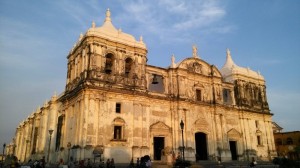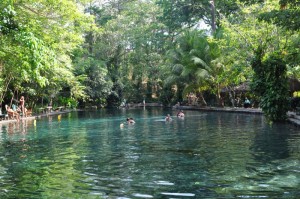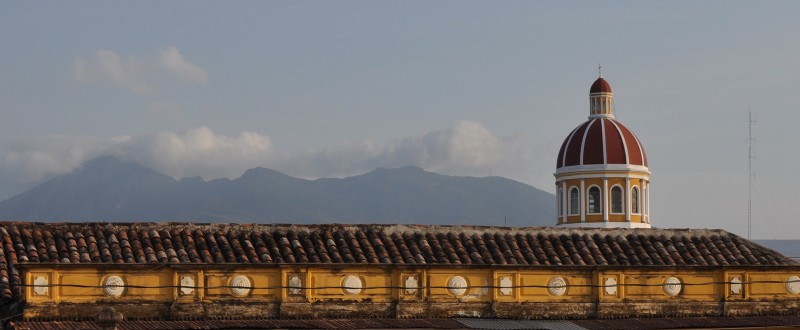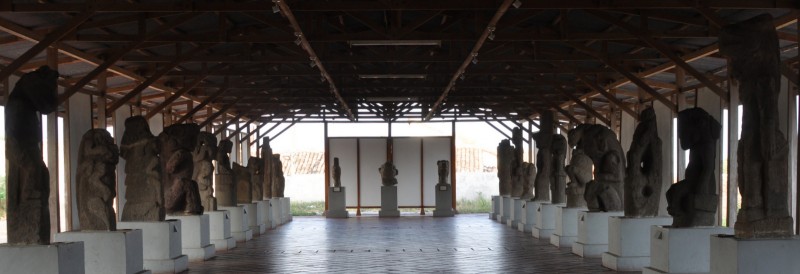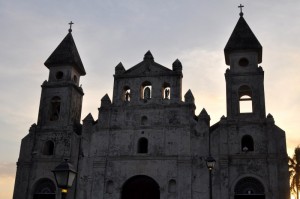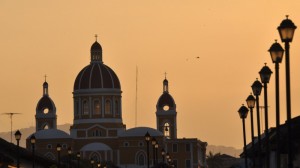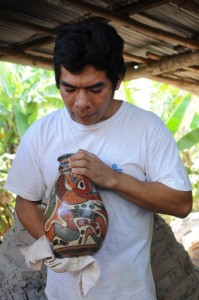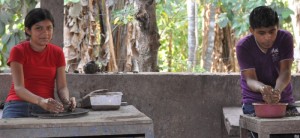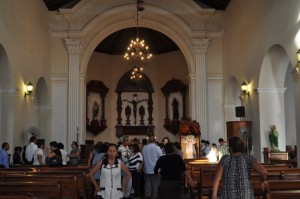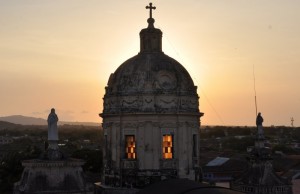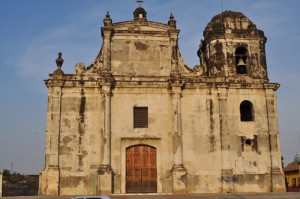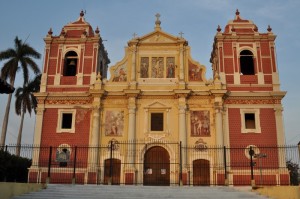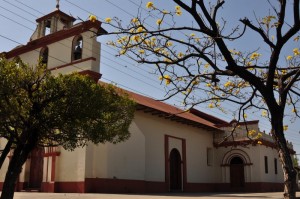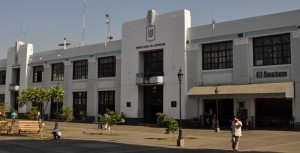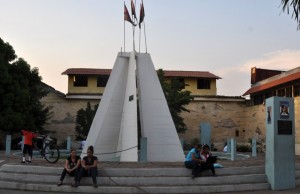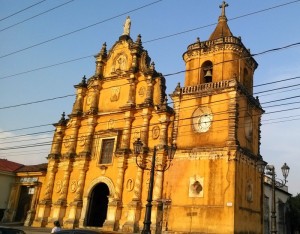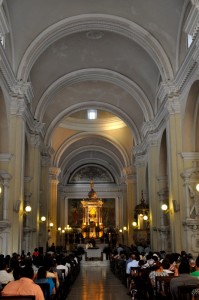Nicaragua known as a land of lakes and volcanoes, remains one of the least visited country. I knew nothing about it except the US’s involvement in the Contra War. My brief stay in Isla Ometepe, Granada and León has given me a glimpse of life in Nicaragua today.Background
Nicaragua is the largest country in Central American Isthmus with an area of 130,370km². The country is physically divided into three major zones: Pacific lowlands; wet, cooler central highlands; and the Caribbean lowlands. It also has the two largest fresh water lakes in Central America – Lake Managua and Lake Nicaragua.
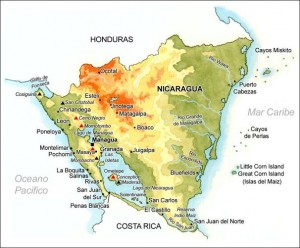 Nicaragua achieved independence from the Spanish in 1821 and became part of the Central American Federation. It finally became an independent nation in 1838. However, it has undergone periods of political unrest. The American adventurist William Walker took control of the government in 1855 and was driven away two years later.
Nicaragua achieved independence from the Spanish in 1821 and became part of the Central American Federation. It finally became an independent nation in 1838. However, it has undergone periods of political unrest. The American adventurist William Walker took control of the government in 1855 and was driven away two years later.
After enjoying a period of relatively prosperity from 1857 to 1893, the country came under the dictatorship of General José Zelaya in 1893 which led to a civil war in 1909 forcing him to resign. US intervention in the country grew from 1912 to 1925 leading to a guerillas campaign under Augusto Sandino in protest of the US military presence. In 1934, Sandino was assassinated on the order of General Anastasio Somoza who became president in 1937 and marked the beginning of another 40 years of dictatorship.
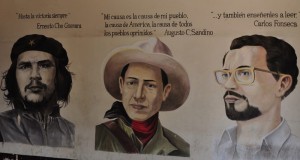 In 1961, Sandinista National Liberation Front (FSLN) was founded leading to a revolution in the 1960s and 1970s. The revolution was won in July 1979 when Liberal Sandinistas gained control. The US was not happy with the left-wing policies of the new government and started funding Contras troops in an anti-Sandinista campaign in 1981. In 1988, FSLN and Contras signed a ceasefire. The country was devastated by Hurricane Mitch in 1998. The country has experienced political stability and economic growth in recent years.
In 1961, Sandinista National Liberation Front (FSLN) was founded leading to a revolution in the 1960s and 1970s. The revolution was won in July 1979 when Liberal Sandinistas gained control. The US was not happy with the left-wing policies of the new government and started funding Contras troops in an anti-Sandinista campaign in 1981. In 1988, FSLN and Contras signed a ceasefire. The country was devastated by Hurricane Mitch in 1998. The country has experienced political stability and economic growth in recent years.
Nicaragua is one of the poorest countries in the Americas. Agricultures constitutes 60% of its export followed by tourism. The GDP (PPP) and GDP-per capita (PPP) (2014 est) is $29.899 billion and $4,849 respectively. It is estimated that about 42.5% of the population in 2009 were below poverty line (2009).
The population of Nicaragua, approximately 6 million, is multiethnic: Mestizo 69%; White 17%; Black 9% and Indigenous 5%. It is rich in tourism resources boasting two cultural World Heritage Sites namely León Cathedral and León Viejo (Old Leon), many beautiful lakes and volcanoes in addition to abundant flora and fauna.
April 23 Wednesday: La Fortuna, Costa Rica – border crossing – Isla Ometepe, Nicaragua (265km: 6hrs + three and a half hours at border)
We were on Nicaraguan soil before 12 noon but had to spend almost two hours at the border. We first filled in a form and handed it to Yves who queued up and dealt with the officials. We were allowed to move freely while our papers were being processed. We re-boarded Bessy in the presence of an immigration officer who handed us our passport with an entry stamp. I changed $20 for Nicaraguan córdoba (C$) and got C$500. I had fish and beans for lunch (C$40)
We arrived at San Jorge within half an hour. Unfortunately, the ferry to Moyogalpa would not be leaving till 3:30pm. I did nothing but wait. It was so hot that I sweated profusely.
The ferry to the twin-volcaned Isla Ometepe, the largest island in Lago de Nicaragua took 40 minutes. I managed to find a place to stand in a quiet corner next to the navigation cabin. Anika joined me and we enjoyed unobstructed views. A young man, Joshua began chatting with us. His family immigrated to the US when he was five. He loves travelling and is now running a small tour company on the island. He gave us a few tips on what to do here and in Roatan, Honduras.
Our hotel is close to the pier. Yves arranged Horacio from a local tour company to give us information on activities for the following day. Most of my friends decided to climb Volcán Maderas (1394m) ($40) or take a leisure island tour ($38 including lunch). As I wanted a hike as well as an island tour, I decided to discuss my plan with Joshua who was already waiting for me and Anika outside our hotel. Eventually he offered us a full-day for $45 including a hike to the look-out point (around 1000m) on Volcán Concepción (1610m) and an island tour but without lunch.
Joshua took us to a local food stall when we paid C$50 for BBQ chicken and plantain. The meat was tender and nicely marinated. Joshua then took us to a local bar where I had 2 mojitos for $1.
April 24 Thursday: Isla Ometepe
Anika and I had a quick breakfast at 4:35am before going to Joshua’s office. Joshua, two English guys on a gap year who would be climbing Volcán Concepción (8-10 hours return) and their guide, Anika and me took the 5am bus to the park. Joshua suddenly offered us horse-riding to the bottom of the volcano. Our horses did not arrive till almost 6am. I was annoyed as I hate wasting time in waiting.
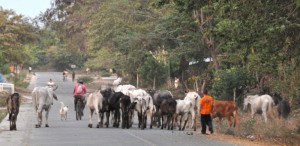 |
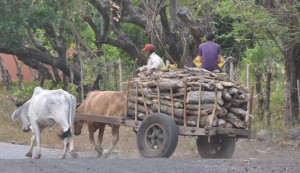 |
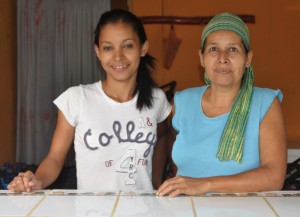 |
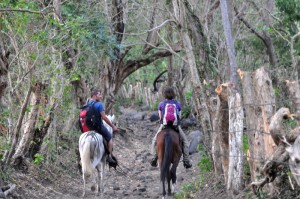 |
My poor pony walked very slowly. We finally reached the starting point just before 7am. I like horse riding and appreciate Joshua’s special offer. The trek is not exceedingly difficult. But the trail going through the forest/jungle affords no view till one goes above the tree-line. We saw half a dozen of howler monkeys and some birds. When we finally reached the viewpoint, it suddenly became very windy, cloudy and misty. So we only stayed for about 10 minutes and took the same way back. Going down is more dangerous as the slope is covered with volcano ash. Both Anika and I fell a couple of times. Luckily we did not get hurt.
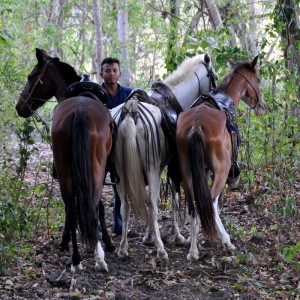 |
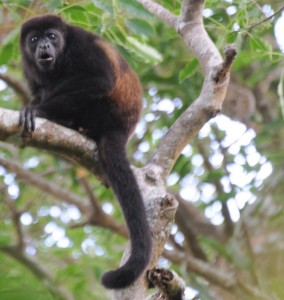 |
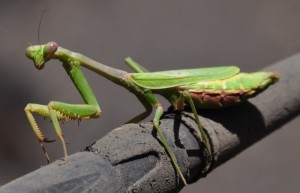 |
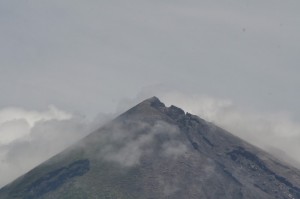 |
It was after 11:30am when we were back on the road where a taxi was waiting for us. Joshua took us to his favourite restaurant at the end of Playa Santo Domingo.
I ordered a steam fish (C$1700) which took a long time to prepare. While I was waiting, I intended to take a walk or swim in the lake. Joshua however dissuaded me. Sadly I took his advice as I did not want to walk under the scorching sun. As a result, I missed an opportunity to have full views of the two volcanos. The steam fish was nice but cannot be compared with what I have in Hong Kong.
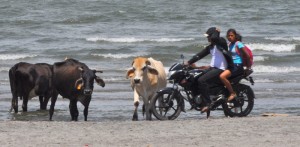 |
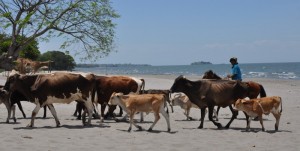 |
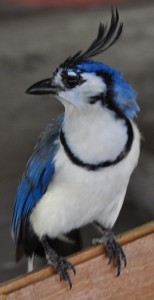 |
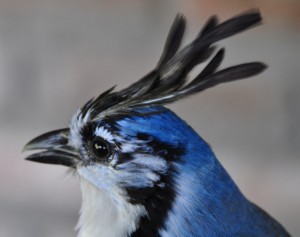 |
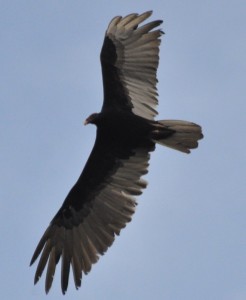 |
After lunch we went to Ojo d’agua, a pool filled with natural cool spring water. The entrance fee was $3 per person. Here people like to drink coco with rum. I had a good swim while Anika and Joshua just took a rest. We then met our friends (Nam, Victoria, Yvonne, Michelle and Emma) on the island tour. I showed them a few basic aqua-aerobic movements: we were a bit carried away and all the people at the pool were gazing at us! We laughed and had lots of fun.
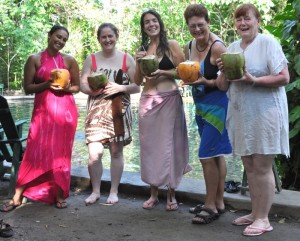 |
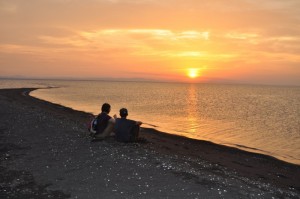 Before 4pm, Anika and I left for the sunset viewing at a sandpit. All tourists were gone and I enjoyed watching a couple fishing sardines for their dinner. The method is very simple: the couple each holds the end of a net, they drop it in the water and raised it after a few minutes. They walked for about 50m on one side of the pit before doing the same on the other side. I was amazed to see they had caught half a bag of sardines (properly about 2kg). The sunset was not as good as the night before. Anika and I had a full and enjoyable day.
Before 4pm, Anika and I left for the sunset viewing at a sandpit. All tourists were gone and I enjoyed watching a couple fishing sardines for their dinner. The method is very simple: the couple each holds the end of a net, they drop it in the water and raised it after a few minutes. They walked for about 50m on one side of the pit before doing the same on the other side. I was amazed to see they had caught half a bag of sardines (properly about 2kg). The sunset was not as good as the night before. Anika and I had a full and enjoyable day.
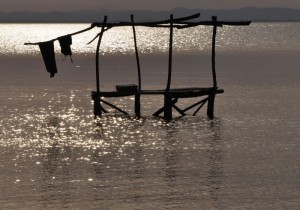 |
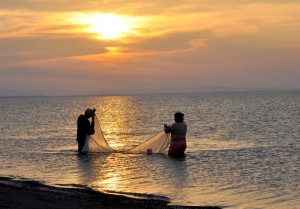 |
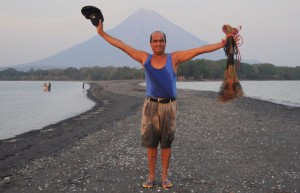 |
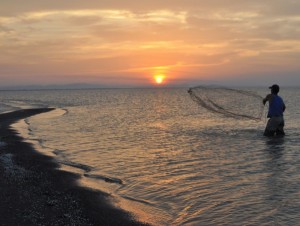 |
April 25 Friday: Granada (75km; 40-minute on ferry & 2 hrs driving)
I got up early and started my morning stroll along the beach shortly after 6am. I love watching locals wading out to the stands near the beach where they wash clothes or themselves.
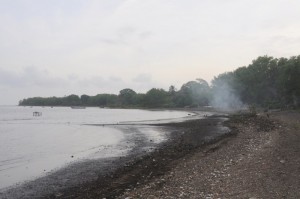 |
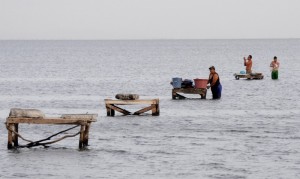 |
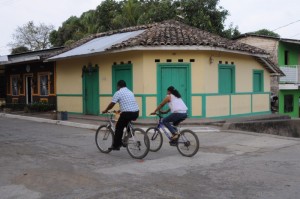 |
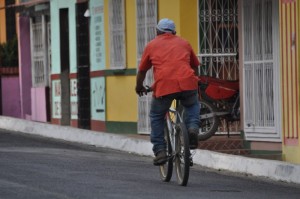 |
When I was packing my bags, I suddenly realized that my two walking poles were still in the boots in the taxi. I was lucky to have kept Joshua’s phone number. I asked Yves to call him immediately. Joshua found the taxi driver who brought my poles back to me at 8:50am.
The boat ride back to San Jorge was uneventful. We boarded Bessy again and arrived at Oasis Hostel in Granada around noon. The place located close to the market is cozy with a small pool. But our room is airless and like an oven. I knew I would have difficulties to sleep.
Tom took us to a nice restaurant called Garden Café. The old colonial building is elegant and charming with a high ceiling and a beautiful garden. The smoothies are fantastic. I had to escape from the heat and stayed at the hotel till 4:30pm.
Granada, the oldest Spanish-built city located at the western shore of Lago de Nicaragua, was once the jewel of Central America. Founded in 1524 by Francisco Fernández de Córdoba, Granada 20km from the Pacific was rich serving as a transit point for shipments of gold and other minerals minded throughout the Spanish empire. William Walker gained control of the city and burnt it down when forced to retreat from his misadventure in Central America. Granada is a magnet for tourists who come to see the studding old colonial buildings many have been restored and use it as a base for exploring the lake.
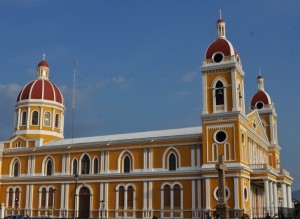 |
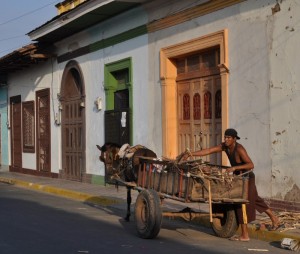 |
The place I first went to see is the Convento de San Francisco. As it would be closing at 5pm, I was allowed to take a 15-minute tour. Originally built in the 16th century, it was rebuilt in 1867 after Walker’s attack. The items of interest here are the petroglyphs most of which were recovered from Isla Zapatera. The statutes depict anthropomorphic creatures- half man, half lizards, turtle or jaguar.
I then walked towards Iglesia Guadalupe near the lake. But Yves had warned us not to go near the river on our own as tourists had been robbed in the dark or early morning. A large stage had just been set up ready for a variety show in the evening. I planned to return to watch it.
The sunset was beautiful and serene: the Cathedral and other churches were all glittering and glowing in orange gold colour. I was taken by surprise when I heard someone talking to me in Chinese. He introduced himself as Frank who has been living and working in China. He is now living in Granada and invited me to try the juice at his friend’s café. I had a refreshing veg juice (C$30) and brought half a roast chicken for C$80.
I returned to the hostel to enjoy my dinner. My stomach was full after having the thigh and drumstick. I was glad when Anika came to my rescue and finish it off. Then I persuaded her to join me for a walk and to watch the cultural show. While it was steaming hot in the hostel, it was nice and breezy outdoor. We watched the show for almost an hour: the dance with colourful costumes from different regions is more interesting. Before returning to the hostel, I persuaded Anika who does not drink to drop by a pub where the rest of the group had gone. This pub offered a Lady’s Night when ladies could have free drink and shots. I am a social drinker: I had a small rum-coke and a shot before returning to the hostel.
The room was so hot that I planned to sleep in the courtyard. Around 11pm, my friends started to come back and some were drunk. One had sadly strained her ankle which left her limping around for the next few days. A few came back around 5am. I wonder whether I had missed out a lot of fun being a dull and not-partying type!
April 26 Saturday: Sightseeing trip (90km)
I hardly slept owing to the heat and stale air in the room. Finally I got up at 6am and spent an hour resting in a hammock. After breakfast, we set off on a guided tour to Masaya, 26km south of Granada.
The first stop was Parque Nacional Volcán Masaya which offers the most accessible volcano-viewing in Nicaragua. As there have been intense volcanic activities stretching from Chile to Central America with the first major eruption in Chile in March this year, Nicaragua has been high alert when a 6.2 earthquake on the scale hit the León region. The park was on Yellow Alert on the day of our visit meaning we could not stay at the crater more than 10 minutes.
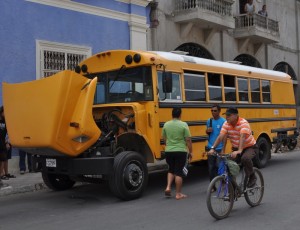 |
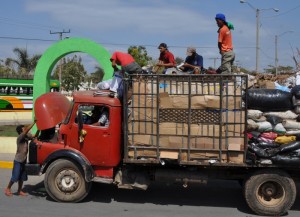 |
We began our tour at the museum which is informative. There are models on the chain of volcanos in the country, plenty of information on their formation and evolution, flora and fauna in the region. I have already seen many amazing volcanoes in Kamchatka, Iceland and Japan. I suppose the only remarkable thing I learn from this visit is about some green parrots which make their nest in holes at the crater. How do they adapt to the heat and sulphur-filled fumes?
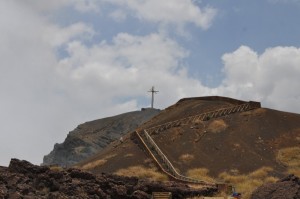 |
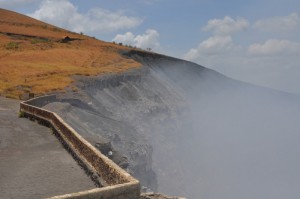 |
Masaya is the country’s centre of artesanía production. Our second stop was the artesian market in Masaya city centre. As I could not find my mobile phone in my bag, I was anxious as I could not afford to lose it. I was desperate to get back to Bessy as I suspected my phone was on my seat or the floor. I was correct: it was lying on the floor below my seat.
The third stop was at a hill top with a panoramic view of Volcán Mombacho and the lake. I was told one could see Granada as well with good weather. I skipped lunch in order to have more time to stroll around. I had a snack though.
Our last stop was a ceramic school with a pottery demonstration by a master who has been working with ceramic since he was five years old. His family has been making ceramic for over a century.
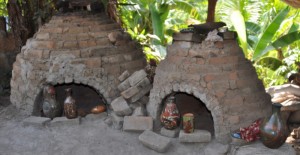 |
My real day started after my return to Granada at 4pm. I wanted to see the interior of the Cathedral and Iglesia San Francisco. I spent a few minutes at the Mass in each place and was impressed by the large and pious crowd in the Iglesia San Francisco.
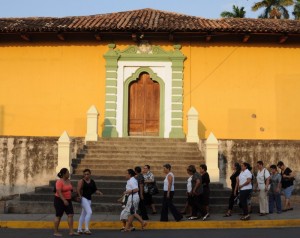 |
I stopped briefly at the Chocolate Museum located in a most beautiful colonial building on my way to Iglesia La Merced which architecture is unique but dilapidated. I climbed 70 steps to reach the top of the clock tower hoping to find AJ doing her ritual dance at sunset. She had not arrived yet and I had to leave for my massage appointment at Coco Berry Spa at 5:30pm. I had a wonderful 90-minute hot volcanic rock massage for $36. I felt so good that I almost fell asleep.
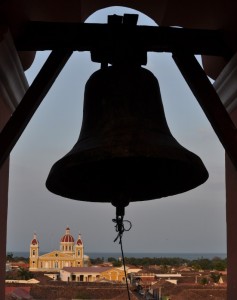 |
I was back to the hostel by 8pm. I must find myself a cooler place to sleep tonight as I could no longer bear the heat in the room. I made myself comfortable in a large sofa-bed in the courtyard. The quiet hours began at 11pm. But a group of reckless young people from Germany, France and the UK continued to talk loudly and play games till midnight. I was very annoyed as they should respect the rules of the hostel. The receptionist on evening shift was too afraid to tell them to shut up.
Anyway, I slept badly as there was no wind. I had some mosquitos/bugs biting me too. I was so hot that I got up in the middle of the night to look for another cool spot. Finally I slept under a fan till 6am.
April 27 Sunday: Granada – León (137km; 3hrs)
The first city named León in Nicaragua was founded in 1524 by Francisco Hernández de Córdoba about 32km east of the present day León. León Viejo was abandoned in 1610 after a series of earthquakes most of them in 1610 at the Momotombo Volcano. The ruins were excavated in 1960.
León had been the capital of Nicaragua since colonial times and became the capital of the new nation in 1839. For some years the capital shifted back and forth between León and Granada with Liberal regimes preferring the former and the Conservative ones Granada. Finally, Managua was picked in 1858 as the capital. León is rich in both monuments and historical places.
We set off after breakfast. The highway is excellent and we took less than three hours to arrive at Hotel Europa in León. Yves arranged us to meet a local tour company which arranged trips for the group. I decided to take the Telica Volcano night trek ($40): I have never seen glowing lava.
At 2:20pm, a truck picked me up and I met four Americans, a German and Nicaraguan on this trek. On the way, we spotted three quetzals (the national bird) which are colourful with a long blue-feather long tail. We began our hike at 4pm and reached the crater an hour later.
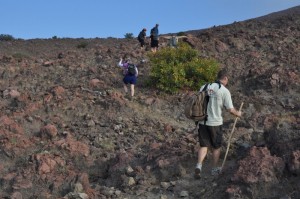 |
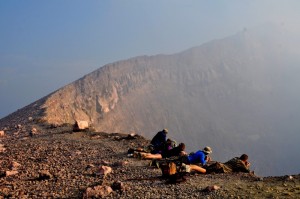 |
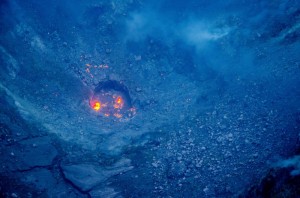 |
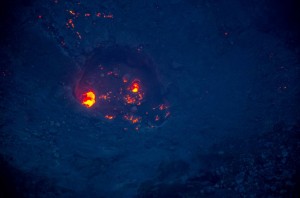 |
Our guide took us to see other parts of the volcano while awaiting sunset. I have watched many beautiful and memorable sunsets. As it was getting dark, we returned to the crater to watch the glowing lava. Well, both phenomena were not as spectacular as I had imagine.
We started the descent shortly after 6pm and the walk was a bit scary due to uneven terrain. Thank God, I had only fallen once. I was back in the hotel at 8:20pm. I had not eaten the whole day and brought some street food with rice, beans and pig knuckles for only C$25.
April 28 Monday: León
I got up before 6am and had breakfast. I paid $4 for a bad cup of coffee with powder milk, an orange juice and a small omelet. I should have gone outside for breakfast.
By 7am, I was out in the streets strolling aimlessly and peeping at some old and crumbling colonial buildings. I found the heat bearable and the light good for photos in early morning. I reached the Parque Centrale which is the pulse of the city and is surrounded by key buildings namely the City Hall and the Cathedral Basilica of the Assumption of León.
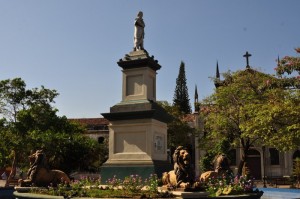 |
The City Hall built in 1935 in Art Deco styles of important architectural value, was badly damaged by Somoza’s National Guide during the Revolution of 1979 led by the FSLN. The Cathedral built between 1714 and 1814 is the largest one in Central America expressing the transition from Baroque to Neoclassical architecture and its style can be considered to be eclectic. The vault of the Sanctuary presents rich ornamentation. The Cathedral houses important works of art including a wooden Flemish altarpiece, and paintings of the 14 stations of the Way of the Cross by Nicaraguan artist Antonio Sarria (late 19th and early 20th centuries).
I then met one of the Americans on the lava glow tour. Both of us were a bit disappointed at the sunset and the lava flow. I tried to invite her to visit León Viejo, one of the oldest Spanish colonial settlements in the Americas and the ruins are outstanding testimony to the social and economic structures of the Spanish Empire in the 16th century. She was not interested: I found a taxi driver who agreed to take me there for $15.The taxi driver whose name is Mariano, is enthusiastic. He took me around to see the remains of the Royal Street, two main churches, a convent and many houses. The site has immense archaeological potential but things to be seen on site now are limited.
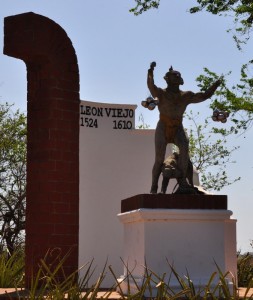 |
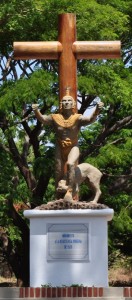 |
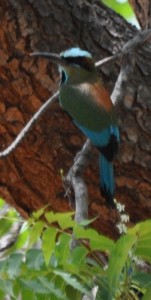 |
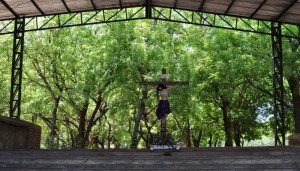 |
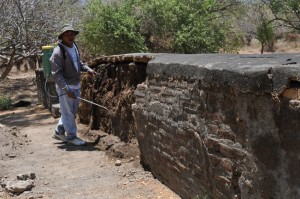 |
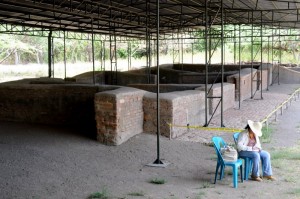 |
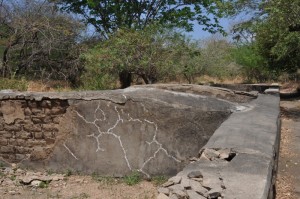 |
Mariano dropped me off at my hotel at 12:30pm. Then he demanded a payment of $50! I was planning to give him $45 as he had waited for me. His attitude put me off. Anyway, as the people here have a hard life and he had done a decent job, I gave him all the money I had in my pocket totally $46.
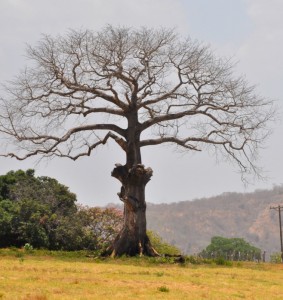 |
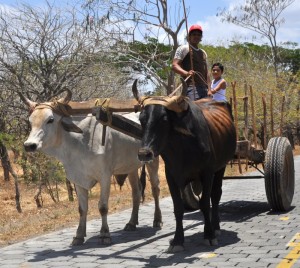 |
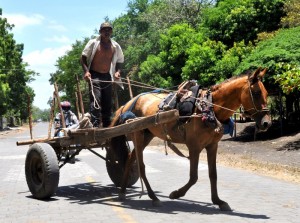 |
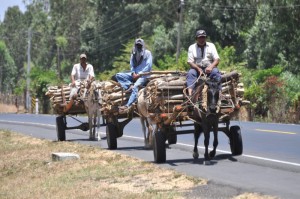 |
I did not go out till almost 5pm as the sun was still very hot. I visited Iglesia La Recolección which architectural style differs from others. The dark wood interior is simple and serene. I reached the Cathedral which was packed by 5pm-mass attendants. It was atmospheric. I spent over two hours wandering through the markets, attending mass services and watching the locals chatting in the park and public squares.
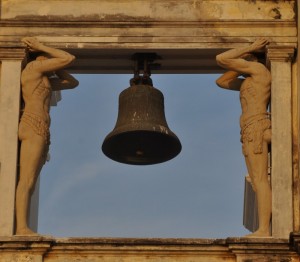 |
It was dark when I began to find my way back to the hotel. It is not easy to recognise the way and I almost got lost. As I remembered the landmarks, I finally found my way back to the hotel without problem.
April 29 Tuesday: León, Nicaragua – Lake Yojoa Honduras (565km; 13hrs + border crossing: 1 hr)
Today, we had the longest driving day on this trip. We set off at 5am and reached the border without problem around 10:30am.
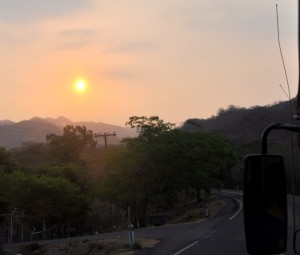 |
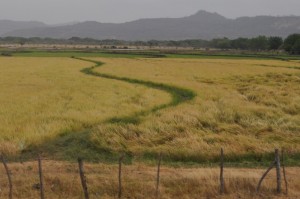 |
As Nicaragua, Honduras, El Salvador and Guatemala have signed the Central American Border Control Agreement (CA-4), tourists may travel within any of these four countries for a period of up to 90 days without completing entry and exit formalities at border and immigration checkpoints. By 11:30am, we had gone through all the formalities in both Nicaragua and Honduras. Fantastic!
Remarks
Nicaragua is worth visiting and has great appeals for cultural tourists, nature lovers and travellers looking for off-beat trails and adventures. The country is lush green with beautiful scenery and rich fauna and flora. It has reasonably good highway system and is trying to build up its tourism infrastructure. Its avenue of volcanoes, beautiful lakes and colonial cities (Granada and León) are great assets. I believe Granada will become a World Heritage Site one day given its history and architectural styles.
The country is the poorest country in Central America and has suffered enough from political and economic instability. It is time to catch up and let the people enjoy better quality of life. I hope more tourists will make their way to less-travelled countries in Central America. Revenue from tourism can make a difference to the people.


